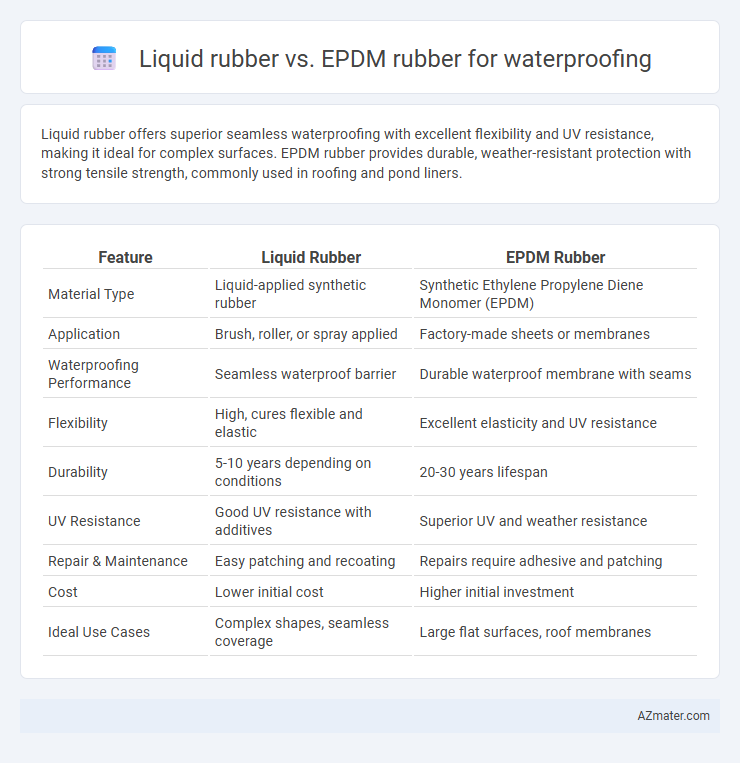Liquid rubber offers superior seamless waterproofing with excellent flexibility and UV resistance, making it ideal for complex surfaces. EPDM rubber provides durable, weather-resistant protection with strong tensile strength, commonly used in roofing and pond liners.
Table of Comparison
| Feature | Liquid Rubber | EPDM Rubber |
|---|---|---|
| Material Type | Liquid-applied synthetic rubber | Synthetic Ethylene Propylene Diene Monomer (EPDM) |
| Application | Brush, roller, or spray applied | Factory-made sheets or membranes |
| Waterproofing Performance | Seamless waterproof barrier | Durable waterproof membrane with seams |
| Flexibility | High, cures flexible and elastic | Excellent elasticity and UV resistance |
| Durability | 5-10 years depending on conditions | 20-30 years lifespan |
| UV Resistance | Good UV resistance with additives | Superior UV and weather resistance |
| Repair & Maintenance | Easy patching and recoating | Repairs require adhesive and patching |
| Cost | Lower initial cost | Higher initial investment |
| Ideal Use Cases | Complex shapes, seamless coverage | Large flat surfaces, roof membranes |
Introduction to Waterproofing Membranes
Liquid rubber and EPDM rubber are widely used waterproofing membranes known for their durability and flexibility in protecting surfaces from water infiltration. Liquid rubber offers seamless application, forming a continuous coating that adheres to irregular shapes and hard-to-reach areas, while EPDM rubber provides a pre-formed, synthetic elastomer sheet renowned for its resistance to UV rays, ozone, and extreme temperatures. Both materials deliver robust waterproof barriers, with liquid rubber excelling in adaptability and EPDM favored for long-term resilience in roofing and foundation applications.
What Is Liquid Rubber?
Liquid rubber is a versatile waterproofing solution consisting of a liquid elastomeric coating that cures to form a seamless, flexible membrane. Unlike EPDM rubber, which is a pre-formed synthetic rubber sheet, liquid rubber can be easily applied to irregular surfaces, ensuring complete coverage and superior adhesion. Its ability to fill cracks and gaps makes liquid rubber highly effective for durable, long-lasting waterproofing in roofing, basements, and other structures.
What Is EPDM Rubber?
EPDM rubber, or ethylene propylene diene monomer, is a highly durable synthetic rubber commonly used for waterproofing roofing systems due to its excellent resistance to UV rays, ozone, and harsh weather conditions. It provides superior elasticity and weatherproofing properties, making it ideal for long-term outdoor applications where flexibility and durability are essential. Unlike liquid rubber, EPDM is typically installed as a pre-formed sheet, offering reliable protection against water infiltration with minimal maintenance.
Key Differences: Liquid Rubber vs EPDM Rubber
Liquid rubber offers seamless application and superior adhesion on complex surfaces, making it ideal for irregular shapes and fast curing times, while EPDM rubber provides excellent UV resistance and long-term durability with strong elasticity and a thicker membrane ideal for large, flat surfaces. Liquid rubber typically forms a flexible, watertight coating that dries quickly and can be applied in multiple thin layers, whereas EPDM rubber comes in sheets that require mechanical fastening or adhesives for installation. The cost-effectiveness of liquid rubber suits smaller or detailed projects, while EPDM is favored for extensive roofing and pond liners due to its robustness and proven lifespan exceeding 20 years.
Waterproofing Performance Comparison
Liquid rubber offers superior flexibility and seamless application, creating a fully adhered waterproof membrane that resists cracking and punctures better than EPDM rubber. EPDM rubber, while durable and UV-resistant, often requires mechanical fastening or adhesives, which can introduce vulnerabilities in waterproofing performance over time. The continuous, self-healing nature of liquid rubber enhances long-term waterproofing integrity, especially on complex or irregular surfaces where EPDM may struggle to maintain a perfect seal.
Application Methods and Ease of Use
Liquid rubber offers a seamless, sprayable or brush-on application that conforms easily to complex shapes and hard-to-reach areas, making it ideal for DIY waterproofing projects and irregular surfaces. EPDM rubber typically comes in sheet form requiring adhesive and careful seam sealing, which demands more expertise and labor for proper installation. The liquid form's quick curing and flexibility simplify repairs, whereas EPDM's durable sheets provide long-term protection but involve more preparation and specialized tools.
Durability and Longevity: Liquid Rubber vs EPDM
Liquid rubber offers superior flexibility and UV resistance, making it highly durable for waterproofing applications exposed to harsh weather conditions. EPDM rubber is renowned for its long lifespan, often exceeding 50 years, with excellent resistance to ozone, temperature extremes, and mechanical wear. Both materials provide strong waterproofing performance, but EPDM's proven longevity makes it a preferred choice for long-term roofing projects.
Cost Considerations for Both Materials
Liquid rubber typically costs less upfront than EPDM rubber, making it an attractive option for budget-conscious waterproofing projects. EPDM rubber, while initially more expensive, offers superior durability and a longer lifespan, which can reduce long-term maintenance and replacement costs. Evaluating total lifecycle expenses reveals that EPDM's higher initial investment may provide better cost efficiency over extended periods compared to liquid rubber.
Environmental Impact and Sustainability
Liquid rubber offers a more environmentally friendly option due to its water-based, low-VOC formula, reducing harmful emissions during application and curing. EPDM rubber, while durable and recyclable, typically involves more energy-intensive manufacturing processes and the use of synthetic chemicals that can have a higher environmental footprint. Both materials provide durable waterproofing, but liquid rubber's sustainable production and application methods make it a preferable choice for eco-conscious projects.
Which Is Better for Your Project?
Liquid rubber offers superior flexibility and easy application on irregular surfaces, making it ideal for complex waterproofing projects requiring seamless coverage. EPDM rubber provides exceptional durability and resistance to UV rays, ozone, and temperature extremes, suited for long-term outdoor installations. Choosing between liquid rubber and EPDM depends on project-specific needs such as surface type, exposure conditions, and desired lifespan.

Infographic: Liquid rubber vs EPDM rubber for Waterproofing
 azmater.com
azmater.com